Headstone

A headstone, or gravestone is a stele or marker, usually stone, that is placed over a grave. A tombstone is a stele or marker, usually stone, that is placed over a tomb. They are traditional for burials in the Christian, Jewish and Muslim religions, among others. In most cases they have the deceased's name, date of birth, and date of death inscribed on them, along with a personal message, or prayer, but they may contain pieces of funerary art, especially details in stone relief. In many parts of Europe insetting a photograph of the deceased in a frame is very common.
Use

The stele (plural stelae), as it is called in an archaeological context, is one of the oldest forms of funerary art. Originally, a tombstone was the stone lid of a stone coffin, or the coffin itself, and a gravestone was the stone slab that was laid over a grave. Now all three terms are also used for markers placed at the head of the grave. Some graves in the 18th century also contained footstones to demarcate the foot end of the grave. This sometimes developed into full kerb sets that marked the whole perimeter of the grave. Footstones were rarely annotated with more than the deceased's initials and year of death, and sometimes a memorial mason and plot reference number. Many cemeteries and churchyards have removed those extra stones to ease grass cutting by machine mower. Note that in some UK cemeteries the principal, and indeed only, marker is placed at the foot of the grave.
Graves, and any related memorials are a focus for mourning and remembrance. The names of relatives are often added to a gravestone over the years, so that one marker may chronicle the passing of an entire family spread over decades. Since gravestones and a plot in a cemetery or churchyard cost money, they are also a symbol of wealth or prominence in a community. Some gravestones were even commissioned and erected to their own memory by people who were still living, as a testament to their wealth and status. In a Christian context, the very wealthy often erected elaborate memorials within churches rather than having simply external gravestones. Crematoria frequently offer similar alternatives to families who do not have a grave to mark, but who want a focus for their mourning and for remembrance. Carved or cast commemorative plaques inside the crematorium for example may serve this purpose.
Materials
A cemetery may follow national codes of practice or independently prescribe the size and use of certain materials, especially in a conservation area. Some may limit the placing of a wooden memorial to six months after burial, after which a more permanent memorial must be placed. Others may require stones of a certain shape or position to facilitate grass-cutting by m, or hand-held cutters. Headstones of granite, marble and other kinds of stone are usually created, installed, and repaired by monumental masons. Cemeteries require regular inspection and maintenance, as stones may settle, topple and, on rare occasions, fall and injure people;[1] or graves may simply become overgrown and their markers lost or vandalised.
Restoration is a specialized job for a monumental mason. Even overgrowth removal requires care to avoid damaging the carving. For example, ivy should only be cut at the base roots and left to naturally die off, never pulled off forcefully. Many materials have been used as markers.
Stone
- Fieldstones. The earliest markers for graves were natural fieldstone, some unmarked and others decorated or incised using a metal awl. Typical motifs for the carving included a symbol and the deceased's name and age.
- Granite. Granite is a hard stone and requires skill to carve by hand. Modern methods of carving include using computer-controlled rotary bits and sandblasting over a rubber stencil. Leaving the letters, numbers and emblems exposed on the stone, the blaster can create virtually any kind of artwork or epitaph.
- Marble and limestone. Both limestone and marble take carving well. Marble is a recrystallised form of limestone. The mild acid in rainwater can slowly dissolve marble and limestone over time, which can make inscriptions unreadable. Portland stone was a type of limestone commonly used in England—after weathering, fossiliferous deposits tend to appear on the surface. Marble became popular from the early 19th century, though its extra cost limited its appeal.
- Sandstone. Sandstone is durable, yet soft enough to carve easily. Some sandstone markers are so well preserved that individual chisel marks are discernible, while others have delaminated and crumbled to dust. Delamination occurs when moisture gets between the layers of the sandstone. As it freezes and expands the layers flake off. In the 17th century, sandstone replaced field stones in Colonial America. Yorkstone was a common sandstone material used in England.
- Slate. Slate can have a pleasing texture but is slightly porous and prone to delamination. It takes lettering well, often highlighted with white paint or gilding. Swithland slate from Charnwood Forest, Leicestershire, England, was used for a large number of very fine gravestones from the later 17th century into the 19th century. The gravestones are found throughout Leicestershire and in neighbouring counties.[2]
-

The Majmuna Stone, a tombstone with an Arabic inscription dated 1174 on a reused Roman marble block. Now exhibited at the Gozo Museum of Archaeology.
-
_grave%2C_Hingham_Center_Cemetery%2C_Hingham%2C_Plymouth_Co.%2C_MA.jpg)
Granite gravestone of Josiah Leavitt (1679–1717), Hingham Center Cemetery, Hingham, Plymouth County, Massachusetts
-
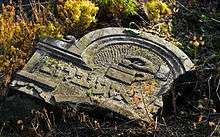
Sandstone vestige of a Jewish gravestone depicting a Tzedakah box. Jewish cemetery in Otwock (Karczew-Anielin), Poland.
-
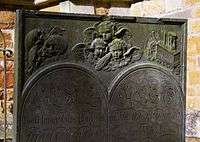
Swithland Slate gravestone, Little Dalby churchyard, Leicestershire
-
Gravestone showing death date of 1639, Wormshill.
-
HIS LAST MESSAGE: NO MORE WARS FOR ME—A headstone in the Jerusalem British World War I Cemetery on Mount Scopus
-

Elaborately carved grave slab at Shebbear (Devon, England) showing a skull sprouting flowering shoots, as a symbol of resurrection
-
Victorian headstones in England
Metal, wood and plants


- Iron. Iron grave markers and decorations were popular during the Victorian era in the United Kingdom and elsewhere, often being produced by specialist foundries or the local blacksmith. Cast iron headstones have lasted for generations while wrought ironwork often only survives in a rusted or eroded state.
- White bronze. Actually sand cast zinc, but called white bronze for marketing purposes. Almost all, if not all, zinc grave markers were made by the Monumental Bronze Company of Bridgeport, CT, between 1874 and 1914. They are in cemeteries of the period all across the U.S. and Canada. They were sold as more durable than marble, about 1/3 less expensive and progressive.
- Wood. This was a popular material during the Georgian and Victorian era, and almost certainly before, in Great Britain and elsewhere. Some could be very ornate, although few survive beyond 50–100 years due to natural decomposition.
- Planting. Trees or shrubs, particularly roses, may be planted, especially to mark the location of ashes. This may be accompanied by a small inscribed metal or wooden marker.
Inscriptions
Markers sometimes bear inscriptions. The information on the headstone generally includes the name of the deceased and their date of birth and death. Such information can be useful to genealogists and local historians. Larger cemeteries may require a discreet reference code as well to help accurately fix the location for maintenance. The cemetery owner, church, or, as in the UK, national guidelines might encourage the use of 'tasteful' and accurate wording in inscriptions. The placement of inscriptions is traditionally placed on the forward-facing side of the memorial but can also be seen in some cases on the reverse and around the edges of the stone itself. Some families request that an inscription be made on the portion of the memorial that will be underground.[3]
In addition, some gravestones also bear epitaphs in praise of the deceased or quotations from religious texts, such as "requiescat in pace". In a few instances the inscription is in the form of a plea, admonishment, testament of faith, claim to fame or even a curse—William Shakespeare's inscription famously declares
Good friend, for Jesus' sake forbear,
To dig the dust enclosèd here.
Blest be the man that spares these stones,
And cursed be he that moves my bones.
Or a warning about mortality, such as this Persian poetry carved on an ancient tombstone in the Tajiki capital of Dushanbe.[4][5]
I heard that mighty Jamshed the King
Carved on a stone near a spring of water these words:
"Many—like us—sat here by this spring
And left this life in the blink of an eye.
We captured the whole world through our courage and strength,
Yet could take nothing with us to our grave."
Or a simpler warning of inevitability of death:
Remember me as you pass by,
As you are now, so once was I,
As I am now, so you will be,
Prepare for death and follow me.


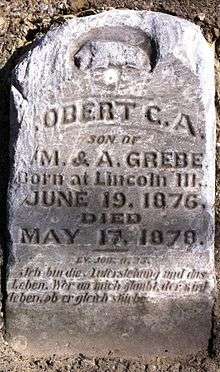
Headstone engravers faced their own "year 2000 problem" when still-living people, as many as 500,000 in the United States alone, pre-purchased headstones with pre-carved death years beginning with 19–.[6]
Bas-relief carvings of a religious nature or of a profile of the deceased can be seen on some headstones, especially up to the 19th century. Since the invention of photography, a gravestone might include a framed photograph or cameo of the deceased; photographic images or artwork (showing the loved one, or some other image relevant to their life, interests or achievements) are sometimes now engraved onto smooth stone surfaces.
Some headstones use lettering made of white metal fixed into the stone, which is easy to read but can be damaged by ivy or frost. Deep carvings on a hard-wearing stone may weather many centuries exposed in graveyards and still remain legible. Those fixed on the inside of churches, on the walls, or on the floor (often as near the altar as possible) may last much longer: such memorials were often embellished with a monumental brass.
The choice of language and/or script on gravestones has been studied by sociolinguists as indicators of language choices and language loyalty. For example, by studying cemeteries used by immigrant communities,[7] some languages were found to be carved "long after the language ceased to be spoken" in the communities.[8] In other cases, a language used in the inscription may indicate a religious affiilation.
Marker inscriptions have also been used for political purposes, such as the grave marker installed in January 2008 at Cave Hill Cemetery in Louisville, Kentucky by Mathew Prescott, an employee of PETA. The grave marker is located near the grave of KFC founder Harland Sanders and bears the acrostic message "KFC tortures birds".[9] The group placed its grave marker to promote its contention that KFC is cruel to chickens.
Form and decoration

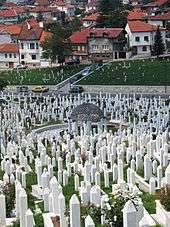
Gravestones may be simple upright slabs with semi-circular, rounded, gabled, pointed-arched, pedimental, square or other shaped tops. During the 18th century, they were often decorated with memento mori (symbolic reminders of death) such as skulls or winged skulls, winged cherub heads, heavenly crowns, urns or the picks and shovels of the grave digger. Somewhat unusual were more elaborate allegorical figures, such as Old Father Time, or emblems of trade or status, or even some event from the life of the deceased (particularly how they died). Large tomb chests, false sarcophagi as the actual remains were in the earth below, or smaller coped chests were commonly used by the gentry as a means of commemorating a number of members of the same family. In the 19th century, headstone styles became very diverse, ranging from plain to highly decorated, and often using crosses on a base or other shapes differing from the traditional slab. They might be replaced by more elaborately carved markers, such as crosses or angels. Simple curb surrounds, sometimes filled with glass chippings, were popular during the mid-20th century.
Islamic headstones are traditionally more a rectangular upright shaft, often topped with a carved topknot symbolic of a turban; but in Western countries more local styles are often used.
Some form of simple decoration is once more popular. Special emblems on tombstones indicate several familiar themes in many faiths. Some examples are:
- Anchor: Steadfast hope
- Angel of grief: Sorrow
- Arch: Rejoined with partner in Heaven
- Birds: The soul
- Book: Faith, wisdom
- Cherub: Divine wisdom or justice
- Column: Noble life
- Broken column: Early death
- Conch shell: Wisdom
- Cross, anchor and Bible: Trials, victory and reward
- Crown: Reward and glory
- Dolphin: Salvation, bearer of souls to Heaven
- Dove: Purity, love and Holy Spirit
- Evergreen: Eternal life
- Garland: Victory over death
- Gourds: Deliverance from grief
- Hands: A relation or partnership (see Reference 3)
- Heart: Devotion
- Horseshoe: Protection against evil
- Hourglass: Time and its swift flight
- IHS: Stylised version of iota-eta-sigma, a Greek abbreviation of Jesus; alternatively treated as an initialism for "in Hoc Signo (VInces)": "In this sign you shall conquer."
- Ivy: Faithfulness, memory, and undying friendship
- Lamb: Innocence
- Lamp: Immortality
- Laurel: Victory, fame
- Lily: Purity and resurrection
- Lion: Strength, resurrection
- Mermaid: Dualism of Christ—fully God, fully man
- Oak: Strength
- Olive branch: Forgiveness, and peace
- Palms: Martyrdom, or victory over death
- Peacock: Eternal life
- Pillow: a deathbed, eternal sleep
- Poppy: Eternal sleep
- Rooster: Awakening, courage and vigilance
- Shell: Birth and resurrection
- Star of David: The God
- Skeleton: Life's brevity
- Snake in a circle: Everlasting life in Heaven
- Swallow: Motherhood
- Broken sword: Life cut short
- Crossed swords: Life lost in battle
- Torch: Eternal life if upturned, death if extinguished
- Tree trunk: The beauty of life
- Triangle: Truth, equality and the trinity
- Tzedakah box (pushke): Righteousness, for it is written "...to do righteousness and justice" (Gen 18:19) and "the doing of righteousness and justice is preferable to the Lord than sacrificial offering" (Proverbs 21:3).
- Shattered urn: Old age, mourning if draped
- Weeping willow: Mourning, grief
Greek letters might also be used:
-
 (alpha and omega): The beginning and the end
(alpha and omega): The beginning and the end -
 (chi rho): The first letters spelling the name of Christ
(chi rho): The first letters spelling the name of Christ
Safety
Over time a headstone may settle or its fixings weaken. After several instances where unstable stones have fallen in dangerous circumstances, some burial authorities "topple test" headstones by firm pressure to check for stability. They may then tape them off or flatten them.
This procedure has proved controversial in the UK, where an authority's duty of care to protect visitors is complicated because it often does not have any ownership rights over the dangerous marker. Authorities that have knocked over stones during testing or have unilaterally lifted and laid flat any potentially hazardous stones have been criticised, after grieving relatives have discovered that their relative's marker has been moved.[10] Since 2007 Consistory Court and local authority guidance now restricts the force used in a topple test and requires an authority to consult relatives before moving a stone. In addition, before laying a stone flat, it must be recorded for posterity.[11][12]
Gallery
-
An example of how old broken gravestones are reused, in this case as paving
-

Typical late 20th century headstone, Dubuque, Iowa
-

19th century marble headstone, Saints Peter and Paul Catholic Church (Sherrill, Iowa)
-
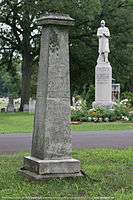
Grave marker for Horatio Nelson Ball and father, Joseph Ball, Jr., Grandville Cemetery, MI, USA.
-
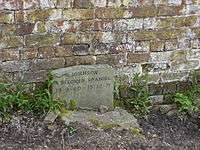
Headstone for a dog, Tatton Park, Cheshire, England.
-

Winged skull & winged soul effigies, Morristown, NJ
-

Unconventional tombstone in the Cemetery Park of the "Freireligiöse Gemeinde" in Berlin, Prenzlauer Berg. Tree stump headstones in U.S. cemeteries are often associated with fraternal organization Woodmen of the World.
-

Der Schlaf (The Sleep), 1907, sculpture at by Hermann Hosaeus at the I. Städtischer Friedhof Eisackstraße
See also
- Epitaph
- Gravestone rubbing
- Khachkar
- Mausoleum
- Megalith
- Sarcophagus
- Scottish gravestones
- Stećak
- Stele
- The Devil's Chair (urban legend)
- Tombstone tourist
- Viewlogy
References
- ↑ Memorial safety Archived 11 June 2007 at the Wayback Machine
- ↑ Burgess, Frederick (1963). English Churchyard Memorials. Cambridge: The Lutterworth Press.
- ↑ Fergus Wessell. "Headstone Gallery". Retrieved 2013-09-05.
- ↑ "Information Clearinghouse". Informationclearinghouse.info. Retrieved 2012-04-19.
- ↑ Robert Fisk: "An urge to smash history into tiny pieces" Information Clearing House The Independent, 8 September 2007
- ↑ Lynch, Michael W. (July 1999). "Grave Problem". Reason. Archived from the original on 11 August 2014. Retrieved 7 September 2014.
- ↑ Doris Francis, Georgina Neophytu, Leonie Kellaher. 2005. The Secret Cemetery. Oxford: Berg.
- ↑ p. 42. Kara VanDam. 2009. Dutch- American language shift: evidence from the grave. LACUS Forum XXXIV 33-42.
- ↑ Bedard, Paul (2008-01-10). "PETA Takes Fight to Col. Sanders's Grave". Usnews.com. Retrieved 2012-04-19.
- ↑ National Federation of Cemetery Friends Safety in cemeteries guidance
- ↑ Ecclesiastical Case Reports Re Keynsham Cemetery Gravestones
- ↑ Advice and guidance from The Local Government Ombudsmen Archived 7 September 2008 at the Wayback Machine
External links
| Wikimedia Commons has media related to Gravestones. |
- In Search Of Gravestones Old And Curious by W.T. Vincent, 1896, from Project Gutenberg
- Azeri.org, Sofi Hamid Cemetery (Azerbaijani)
- World Burial Index Photographs of memorial inscriptions plus free surname search
- A Very Grave Matter Old New England gravestones
- Historic Headstones Online Project to transcribe content from historic headstones
- Pennsylvania German tombstones
- Stockton University includes gravestone imagery in New Jersey, USA
- How to clean a Grave marker by Ralf Heckenbach
- Stone Quarries and Beyond
- "Memorializing the Civil War Dead: Modernity and Corruption under the Grant Administration", by Bruce S. Elliott, in Markers XXVI, Association for Gravestone Studies, 2011, pp. 15–55. (Reprinted with permission of the "Association for Gravestone Studies". (Details the beginning of the mass production of cemetery stones and the increased use of the sand blast process.)
| ||||||||||||||||||||||||||
|